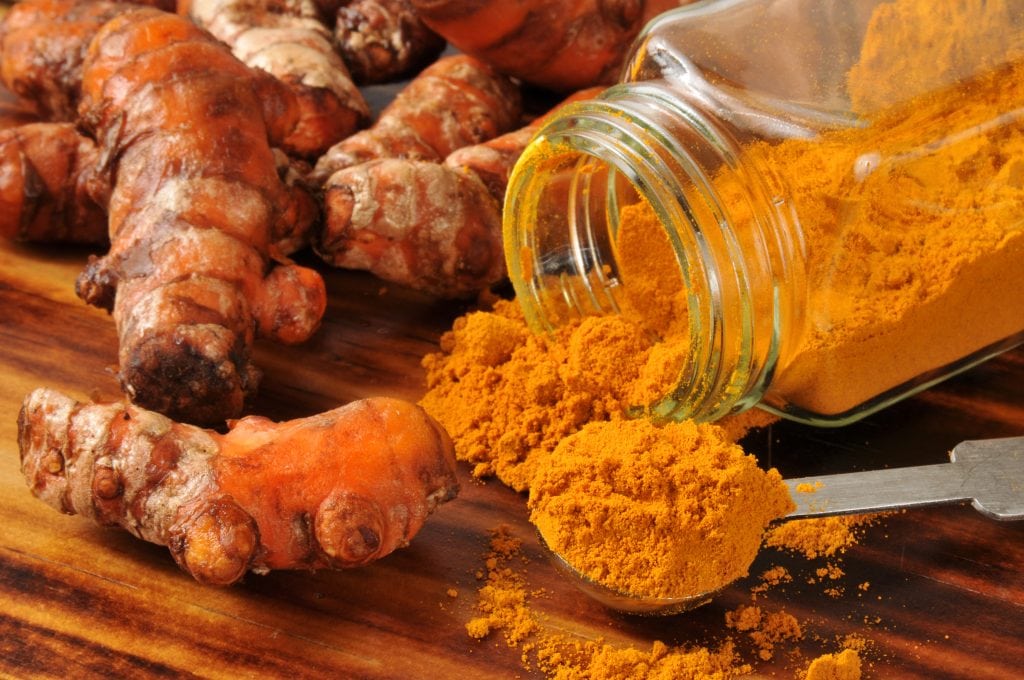
Turmeric: The Popular Ingredient that Won’t Go Out of Style

There is no denying it – turmeric is hot in the nutrition world right now. It’s being taken in supplement form, used as a spice in a wide variety of foods, and even getting made into a drink that rivals your daily latte, golden milk! Whether you’re a turmeric snob or a newbie to the scene, we believe that this powerful ingredient will be sticking around for the long haul. Turmeric is a great example of a functional food: a food that can be used in a variety of ways, for both preventive purposes and medicinal treatments. If it’s not a staple in your pantry or a regular ingredient in your recipes, we hope this post will encourage you to make it a daily practice. So, let’s unpack turmeric: what is it, what is it used for, how and when should you consume it, and is it safe for everyone?
What is Turmeric?
Turmeric originates from the Curcuma longa plant that grows in India and other countries in Southeast Asia; when the plant is dried, it can be ground into the vibrant turmeric powder that we all know and love (1)! The spice is commonly used in Indian cuisine, and its yellow color comes from curcumin, the active chemical in turmeric that is credited for many of its medicinal and functional properties (2). Curcumin is jam-packed with incredible antioxidant properties that fight inflammation and diseases such as heart disease, cancer, metabolic syndrome, Alzheimer’s, and other chronic autoimmune conditions that are tied to inflammation (3). Thus, the more anti-inflammatory compounds we can introduce to our bodies to fight the necessary consequences of a poor diet, oxidative stress, and toxic load, the better!
Turmeric is one of the most well known and well-researched spices in the Ayurvedic diet and lifestyle, where it has been used both fresh and as a dried spice powder for centuries. It is believed to kindle the digestive fire and support the blood, liver, joints, immune system, and digestive tract. Ayurvedic medicine has long been using the whole turmeric root, without isolating the curcumin, which goes against the belief that you must extract the curcumin component to receive the full benefits. Rather, Ayurveda shows that using the entire plant in the way nature intended can be beneficial to get a wide variety of vitamins and minerals. Turmeric is also popular in different yogic traditions and said to cleanse the chakras (9).
If you’ve never gone out of your way to seek out turmeric, you have probably consumed it through Indian food, especially curry, where it takes a starring role. However, you can buy turmeric supplements or the spice in most local grocery stores or online. Even better, you can make your own spice at home by growing your own turmeric to ensure that it stays pure! If you use fresh turmeric, you can grate it into your smoothies, juices, curries, and salads, or you can grind it into its traditional powdered form. Take note, turmeric plants must be uprooted between 7-10 months of age for prime drying time. However, powdered turmeric can be stored far longer than fresh turmeric, which is why you primarily see it in the spice aisle (4)!
The Many Uses of Turmeric
The benefits of turmeric are plentiful, and it is praised for its high concentration of polyphenols, flavonoids, ascorbic acid (vitamin C), and antioxidants. One study showed that turmeric might be able to help reduce the oxidative stress induced by environmental toxicants in rats by up-regulating antioxidant enzymes and helping to clear the blood and liver of toxic load (5). Because turmeric is both anti-inflammatory and antimicrobial, it has been shown to have therapeutic benefits for skin health on conditions like acne, dermatitis, and psoriasis, when ingested or used topically (6). While it is used in many beauty products, you can also make your own skincare product using turmeric, yogurt, and even essential oils. However, be wary of the yellow staining you may experience for a short amount of time. We recommend testing a small amount on your hand before using the mixture on your face (9).
Turmeric promotes weight loss and water retention due to inflammation, reduces bad cholesterol and lowers blood pressure, and relieves joint pain from arthritis or chronic disease (3). Some of its less well known benefits are its ability to slow or prevent blood clots, reduce depression symptoms through curcumin’s effect on neurotransmitters, and fight cancer, irritable bowel syndrome (IBS) (including ulcerative colitis and Crohn’s disease), and toxic load (1). Lastly, turmeric has been shown to combat high blood sugar, which is crucial for every individual, especially those at risk of diabetes (3). One study showed that the curcumin in turmeric is 400 times more potent that metformin, a common diabetes drug, in activating AMP-activated protein kinase, which is a therapeutic target for type 2 diabetes and crucial in reducing insulin resistance. Curcumin may also inhibit the growth of fat cells, which is important in the fight to reduce both obesity and diabetes (1).
How Do I Use Turmeric?
As mentioned above, turmeric can be ingested in its freshest form, supplement form, powder form, or even topically in skincare products. It is important to note how and when you are consuming turmeric in order to achieve the optimum benefits. Certain turmeric supplements include Bioperine, an extract that is derived from black pepper and increases the bioavailability of curcumin, which means it can be more readily absorbed into the bloodstream (3).
Curcumin’s absorption is also increased by fasting, so many sources recommend that you consume turmeric before a meal or at least 3 hours into the postprandial state (after a meal). Thus, while turmeric is in many foods, it’s best when put to use separately from a meal. Some studies encourage users to avoid taking turmeric supplements or eating something with turmeric too close to bedtime, as it can disrupt your sleep (7). However, others are a fan of using turmeric products, such as golden milk, to replace a nightcap and wind down at the end of a long and stressful day (10).
A wide variety of sources agree that turmeric is extremely safe for almost any individual. With over 10,000 peer-reviewed journal articles studying this incredible substance, there are very few known side effects, and even the ones that have been noted are extremely mild (1).
Getting Creative with Your Turmeric
Now that you know the science behind turmeric, let’s not forget one of its most important qualities – it tastes amazing! There are SO many ways to get your turmeric into your daily diet, whether you choose a supplement form or a fresh variety. If you are looking to use it in your meals, cook a curry, season roasted veggies, blend it into a soup or smoothie, or sprinkle it on a salad! You can even make a homemade toothpaste by mixing the powder with coconut oil and baking soda, or you can find a brand that sells toothpaste infused with turmeric. While turmeric doesn’t stain your teeth, be warned, it will stain just about everything else! Lastly, you can concoct a turmeric tea or golden milk, which is a great way to drink your turmeric in between meals (8). If you’re looking for a delicious golden milk recipe, we’ve linked one of our favorites here: https://nutritionstripped.com/
Turmeric is used in several of our supplements, including our Immune IQ drops. This product supports optimal immune health, promotes lymphatic drainage, defends against immune challenges, and supports white blood cell production. In our Bone Broth IQ supplement, turmeric root also takes a starring role to help promote joint function, enhance mobility, and combat aging by working with the collagen in bone broth. Both bone broth and turmeric aid in gut health, making them the perfect pair to promote daily digestive processes.
While turmeric is not the only ingredient in either of these formulas, it is a powerhouse to be reckoned with and is an incredible preventative supplement, even if you’re not battling a specific illness. If you’re inspired by this post to incorporate turmeric into your daily routine or make a specific recipe, we’d love you to share with us in the comments below! If you know of another turmeric use that we didn’t mention, make sure to let us know, as well!
References:
-
https://www.turmericforhealth.
com/general-info/how-to-make- turmeric-powder-at-home-from- raw-turmeric -
Hossen, M. S., Tanvir, E. M., Prince, M. B., Paul, S., Saha, M., Ali, M. Y., & … Karim, N. (2017). Protective mechanism of turmeric (Curcuma longa) on carbofuran-induced hematological and hepatic toxicities in a rat model. Pharmaceutical Biology, 55(1), 1937-1945. doi:10.1080/13880209.2017.
1345951 -
Vaughn, A. R., Branum, A., & Sivamani, R. K. (2016). Effects of Turmeric (Curcuma longa) on Skin Health: A Systematic Review of the Clinical Evidence. Phytotherapy Research: PTR, 30(8), 1243-1264. doi:10.1002/ptr.5640
-
https://foodbabe.com/15-ways-
to-add-anti-inflammatory- turmeric-root-to-your-life/ -
https://www.banyanbotanicals.
com/info/ayurvedic-living/ living-ayurveda/herbs/ turmeric/











